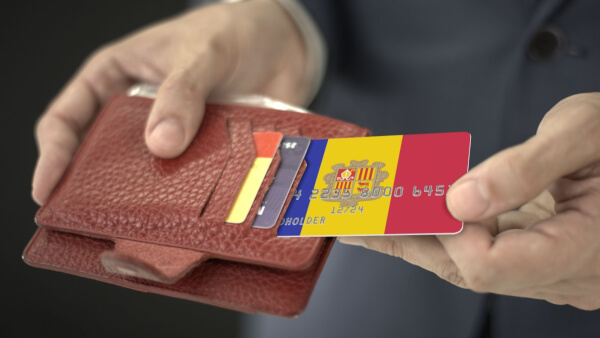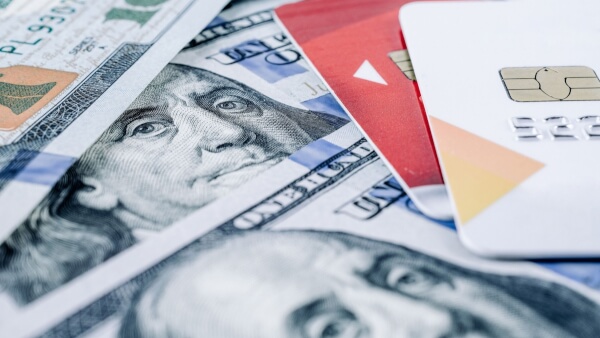Best savings accounts for non-UK residents
Read our roundup of the best savings accounts for non-UK residents, including options from Barclays, HSBC Expat, NatWest and Skipton International.

Just moved to the US from the UK, or planning to relocate there soon? Perhaps you’ll soon be studying there, or are planning an exciting gap year adventure along Route 66.
Whatever your reasons for visiting the US, one of the first things you’ll need is a bank account. If you want to earn money during your trip, pay for things or receive money from home, it’s a must-have.
In this guide, we’ll cover all the essentials you need to know about opening a bank account in the US. This includes the documents you’ll need, how to choose the right bank and crucially, how much a US bank account may cost you.
We’ll also show you a smart alternative to a bank account from the money services provider Wise - the Wise account. It’s not a bank account but offers some similar features, and your money is safeguarded.
Over 14.8 million people worldwide use Wise to send, spend and convert money in pounds, euros and 40+ more currencies – for low, transparent fees and mid-market exchange rates close to what you can see on Google. Plus, you’ll get dedicated support and volume discounts when sending large amounts.
➡️ Learn more about the Wise account
| Please see the terms of use and product availability for your region or visit Wise fees and pricing for the most up to date pricing and fee information. |
|---|
You might find it difficult to open a US bank account if you’re not yet living there, as most US banks either ask for a US social security number (SSN) and a US address, or simply don’t offer non-resident accounts. Those that do may insist on an in-person visit to a branch to complete the process.¹
So if you’re a non-resident, you’ll need to follow these steps:
A common stumbling block for non-residents and new arrivals is the need to have a social security number.
The good news is that some banks will accept applications from foreigners who don’t have, and aren’t eligible for an SSN.
Others may accept something called an ITIN, in place of an SSN. This stands for Individual Taxpayer Identification Number, and it’s used to help foreigners or people not eligible for an SSN to comply with US tax laws.¹
If you’re a US resident with all your paperwork and an SSN, you should be able to open an account online with most banks. Alternatively, you can visit a branch.
It isn’t absolutely essential to have a local bank account in order to move to the US, nor is it a legal requirement.
You may be able to manage without one, and you can instead make use of multi-currency solutions such as the Wise account to send, spend and receive money.
But you might find that day-to-day life in the US is more complicated if you don’t have any kind of local current account or international account in US dollars.
Paying taxes, rent and bills can be more of a headache, as can getting a mortgage and getting paid by your employer if you’re working.
To avoid the hassle of having to open a new bank account in the US, you might be tempted to simply keep using your UK account. Whether or not you can do this will depend on your UK bank.
Major UK banks such as Barclays have closed the accounts of British people living overseas.²
There are some exceptions, such as for UK Crown employees and people who are only planning to live abroad for less than 6 months.²
Other banks take a different approach. International bank Santander says it will continue to service accounts when the holder moves abroad.³ The only stumbling block there though is that while Santander does have a presence in the States, it doesn’t operate everywhere - so you might find it difficult to access branches and ATMs.
Another important thing to bear in mind though is the currency. If you’re using a UK bank account, it’ll likely be denominated in GBP. You’ll be spending in USD while in the US, so you could lose out when it comes to currency exchange.
So all things considered, it could be a better idea to close down your UK account and get a fresh start, opening a US bank account when you arrive.
Yes, as long as you have the right paperwork, you should be fine to open a bank account in the US as a British expat.
You’ll find customer services at US banks to be welcoming and friendly, and of course everything is in English - this is one of the main reasons why it’s such a good country to move to from the UK.
Yes, UK expats who are permanently resident in the US should have no problems opening a bank account online at most major banks.
If you’re not yet living in the US, you may find things more difficult. Not all US banks offer account options for non-residents, not unless you have a social security number and a local address. They may also require at least one in-person visit to verify your identity.
So, you may need to contact a few banks to find out their requirements and options for applying online - or at least starting the process by completing an online application form.
A number of banks in the US offer specialist accounts for students, and you can apply as an international student at most.
Options include Bank of America Student Banking, the Chase College Checking Account and the Wells Fargo Everyday Checking Account.²
The documentation you’ll need to support your application for a bank account can vary. It depends on the bank, as well as the US state.
But generally speaking, here are the documents and details you’re likely to need to open a bank account in the US:
Your UK passport is the best form of photo ID you can provide, and it’ll be accepted as proof of identification by all US banks. However, you can also provide your driving licence.
You may also be asked for your immigration documents, such as your visa or Green Card.
US banks usually want to see proof of a residential address in the US. Recent utility bills, bank statements, credit card statements and mortgage documents (if you’ve bought a property in the US) should all be acceptable evidence for this.
In most cases, banks will ask for your social security number (SSN) and card. There are some exceptions though, such as Bank of America - which asks for extra ID in lieu of this.³
In other cases, the bank may accept an Individual Taxpayer Identification Number (ITIN) instead.
You can apply for an ITIN if you’re a non-citizen and non-resident of the US, if you’ll be filing a US tax return or are married to a US citizen, along with a number of other eligibility criteria.⁴
Some banks will want to see evidence for where your initial deposit came from, for which you can provide bank statements.
If you’re starting your search for a US bank account, here are a few of the the most expat-friendly banks to consider:
Owned by world banking giant JPMorgan Chase, Chase offers a range of accounts for everyday banking, kids and students, and premium users too.
Its everyday checking (current) accounts include its most popular, Chase Total Checking, which charges no fees if you deposit more than $500 USD a month.⁵
Chase also offers a wide range of checking accounts for kids and students. If you’re looking for expat wealth management services, you might also want to take a look at the bank’s Chase Sapphire Banking and Chase Private Client Checking accounts for premium users.
Another of the country’s largest banks, Bank of America (BoA) offers one main product for consumer banking - Advantage.
However, you can choose one of three checking accounts under the Advantage umbrella. Options include Advantage Plus for everyday banking, the digital-only Advantage SafeBalance or the perk-stuffed Advantage Relationship (although you’ll need a higher balance to get the benefits).
While Bank of America doesn’t offer a dedicated student account, students can access some Advantage accounts with waived monthly fees.
BoA is also a good choice for non-resident applicants, as it doesn’t ask for a social security number - only proof of an address in the US and plenty of ID.³
Citibank’s checking accounts are based on relationship tiers – in a nutshell, how much money on average you’re keeping with Citibank.
With the lowest tier, you won’t need to maintain a certain balance on the account, and the monthly fees can be waived when meeting certain requirements, like depositing money into your account regularly.
There are also premium packages available, based on the combined average monthly balance: Citi Priority (starting from $30,000), Citigold (starting from $200,000), and Citigold Private Client (starting from $1 million).⁶
Unfortunately, Citibank doesn’t offer a dedicated account for students.
Another of America’s ‘Big Four’ banks, Wells Fargo offers a choice of everyday checking accounts suitable for expats.
This includes an Everyday Checking account, which is fee-free for young people aged 17-24 and for those who can pay in at least $500 USD a month.⁷
There’s also Clear Access Banking, another checking account targeting students and young people. It offers the same option to waive the monthly fee if you meet certain criteria. Plus, it’s designed specifically with digital-loving users in mind, with a great mobile banking app, contactless debit card and other digital banking features.
If you don’t fancy using a traditional bank, there are also a large number of neobanks, money apps and digital alternatives available in the US, such as:
Other money management alternatives worth looking into are providers like Wise and Revolut, which don’t have banking licences in the US but offer many of the same features as a bank account. This includes sending and receiving money.
| 📚 Read more: Best expat bank accounts in the UK |
|---|
Just like in the UK, there are some fees and costs to look out for when banking in the US.
These vary between banks, and you should check the small print before signing up for an account. But here’s a roundup of what to expect:
| Transaction/fee type | Typical fee |
|---|---|
| Current account - monthly fee | $0 to $35⁷ |
| ATM cash withdrawal | - Usually free at your own bank’s ATMs - Around $3 at other bank’s ATMs⁸ |
| Getting a debit card | Usually free |
| Domestic payments (i.e. within the US) | Usually free |
| International payments (i.e. to the UK from the US) | Up to $50 + additional correspondent/receiving bank fees⁸ |
While most US bank accounts come with monthly fees, they can usually be waived if you meet certain conditions. For example, paying in a minimum amount each month or maintaining a minimum monthly balance. Young people and students can also benefit from waived fees at many banks.
Although there may be no monthly fees, bear in mind that there may be other fees to pay - such as for using non-network ATMs or sending international transfers.
If you need to send money back home to the UK from the US, or whizz it across to a friend in another country, there is an alternative to using your bank.
Open a Wise account and you can convert currencies or send money to and from the UK, the US and many other countries.
You can also get a Wise card to spend in 160+ countries. This smart debit card automatically converts your money to the local currency at the mid-market exchange rate, only adding a tiny currency conversion fee. Or it’s free if you already have the currency in your Wise account.
| Here’s an overview of the main benefits of using Wise: |
|---|
|
Sources used:
Sources last checked on date: 10-Dec-2025
*Please see terms of use and product availability for your region or visit Wise fees and pricing for the most up to date pricing and fee information.
This publication is provided for general information purposes and does not constitute legal, tax or other professional advice from Wise Payments Limited or its subsidiaries and its affiliates, and it is not intended as a substitute for obtaining advice from a financial advisor or any other professional.
We make no representations, warranties or guarantees, whether expressed or implied, that the content in the publication is accurate, complete or up to date.

Read our roundup of the best savings accounts for non-UK residents, including options from Barclays, HSBC Expat, NatWest and Skipton International.

Check out our essential guide on how to open a bank account online, including bank types, required documents, fees, and more.

Check out our essential guide on how to open a bank account in Jersey as a British expat, including documents, fees, banks and much more.

Check out our essential guide on how to open a bank account in Monaco as a British expat, including documents, fees, banks and much more.

Check out our essential guide on how to open a bank account in Andorra as a British expat, including documents, fees, banks and much more.

Read our rundown of the best Nationwide USD account alternatives available in the UK, including HSBC, Lloyds, Wise, Barclays, Revolut and more.